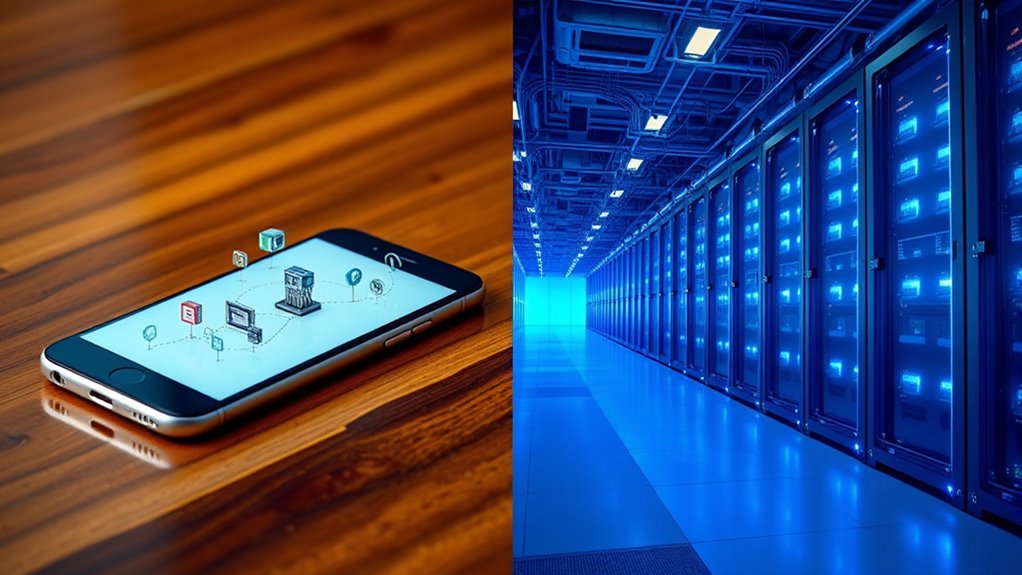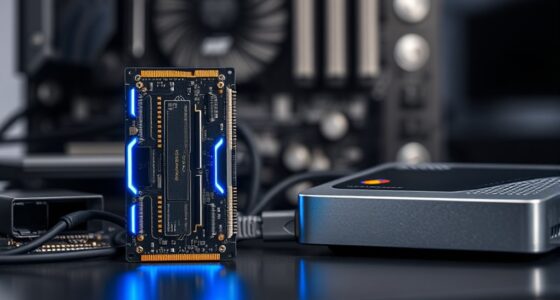On-device AI processes data locally on your device, offering better privacy and offline use, while cloud AI relies on remote servers for processing, providing stronger capabilities but raising privacy and connection concerns. With on-device AI, your data stays private and tasks are completed quickly without internet, but it needs powerful hardware. Cloud AI handles complex tasks more easily but depends on a stable internet connection. To understand which suits you best, keep exploring the differences.
Key Takeaways
- On-device AI processes data locally on the device, ensuring privacy and offline functionality, while Cloud AI transmits data to external servers for processing.
- Cloud AI generally offers more powerful processing capabilities and easier data management due to centralized storage.
- On-device AI requires robust hardware, which can increase costs and limit model complexity; Cloud AI reduces hardware demands on devices.
- Data synchronization across multiple devices is more challenging with on-device AI, whereas Cloud AI maintains consistency through centralized data.
- The choice depends on priorities: privacy and offline use favor on-device AI, while advanced features and easier updates favor cloud AI.

As artificial intelligence continues to evolve, you’re often faced with a choice between on-device AI and cloud AI for your applications. Each option offers distinct advantages and challenges, especially when it comes to privacy concerns and data synchronization. On-device AI runs directly on your device—like your smartphone, tablet, or IoT gadget—keeping data local. This means that sensitive information doesn’t leave your device, reducing the risk of data breaches and addressing privacy worries. If you’re handling personal health data or confidential business info, on-device AI gives you more control over who accesses your data. Plus, since it doesn’t rely on constant internet connectivity, it can operate seamlessly even when offline, making it faster and more reliable in environments with poor network coverage.
On-device AI keeps data local, enhancing privacy and offline reliability for your applications.
However, on-device AI also introduces unique challenges. You need sufficient processing power and storage capacity on your device, which can increase hardware costs or limit the complexity of AI models you can deploy. Additionally, keeping data synchronized across multiple devices can get complicated. If you use an on-device AI system on your phone and tablet, ensuring that updates, preferences, or learned models stay consistent across all devices requires effective data synchronization mechanisms. Without proper synchronization, you risk inconsistent outputs or outdated information, which can diminish the AI’s usefulness. The hardware capabilities of devices also play a significant role in determining the effectiveness of on-device AI.
On the other hand, cloud AI relies on servers and data centers to process your data. When you send data to the cloud, you benefit from powerful computational resources that can handle complex AI models and large datasets. This often results in more sophisticated features and improved accuracy. Cloud AI also simplifies data synchronization because the central server maintains the latest version of your data and models, ensuring consistency across all your devices. This makes it easier to manage updates and share insights seamlessly, especially when working across multiple platforms.
But cloud AI isn’t without its drawbacks. The primary concern revolves around privacy; sending sensitive information over the internet raises risks of interception or unauthorized access. Even with encryption, some users worry about data being stored or processed on external servers. Furthermore, cloud AI depends on a stable internet connection. If your connection drops or becomes slow, your applications might lag or become unusable, which can be frustrating in critical situations.
In essence, your choice between on-device AI and cloud AI hinges on your priorities. If privacy and offline functionality matter most, on-device AI could be the better fit. If you prefer advanced capabilities, easier data management, and cross-device synchronization, cloud AI might serve you better.
Frequently Asked Questions
How Does Latency Differ Between On-Device and Cloud AI?
You’ll notice that latency is generally lower with on-device AI because it handles local processing directly on your device, avoiding delays caused by network dependency. Cloud AI, however, relies on transmitting data over the internet, which can introduce latency issues depending on your connection speed and network stability. So, for real-time responses and minimal delays, on-device AI usually performs better than cloud AI.
What Are the Privacy Implications of On-Device Versus Cloud AI?
You have more control over your data with on-device AI, as it keeps data locally, reducing privacy risks and easing data ownership concerns. Cloud AI, however, involves transmitting data to remote servers, which can raise compliance challenges and potential security vulnerabilities. With on-device AI, you face fewer privacy issues, but cloud AI may require stricter adherence to privacy regulations. Ultimately, your choice impacts how securely you manage your data.
Which AI Type Is More Cost-Effective Long-Term?
Opting for on-device AI tends to be more cost-effective long-term because it reduces ongoing expenses like data transmission and cloud service fees. Your cost analysis shows lower maintenance costs, making it a smarter choice over time. While cloud AI may seem convenient initially, the cumulative expenses for bandwidth and storage can add up. Ultimately, on-device AI offers a smoother financial journey, saving you money as your needs grow.
Can On-Device AI Handle Complex Processing Tasks?
Yes, on-device AI can handle complex processing tasks, especially with advancements in edge computing. However, its ability depends on the device’s computational complexity and hardware capabilities. While it’s suitable for many real-time applications, highly demanding tasks may still require cloud AI for more extensive processing power. You should evaluate your specific needs, considering the trade-offs between on-device processing limits and cloud-based computational strength.
How Does Data Security Compare in Both AI Approaches?
You’ll find that data security differs between on-device and cloud AI. With on-device AI, data stays on your device, giving you better control over data ownership and reducing risks of breaches. It uses data encryption locally, but may have limited security updates. Cloud AI, however, stores data on remote servers, which can be more vulnerable but often benefits from advanced security measures and constant updates, impacting how you manage data privacy.
Conclusion
Ultimately, choosing between on-device AI and cloud AI depends on your needs. On-device AI offers speed and privacy, while cloud AI provides scalability and powerful processing. Think of it like the saying, “Don’t put all your eggs in one basket”—consider what matters most to you. By understanding their differences, you can make smarter choices, ensuring your AI solutions fit perfectly with your goals. After all, a wise decision is a well-informed one.









